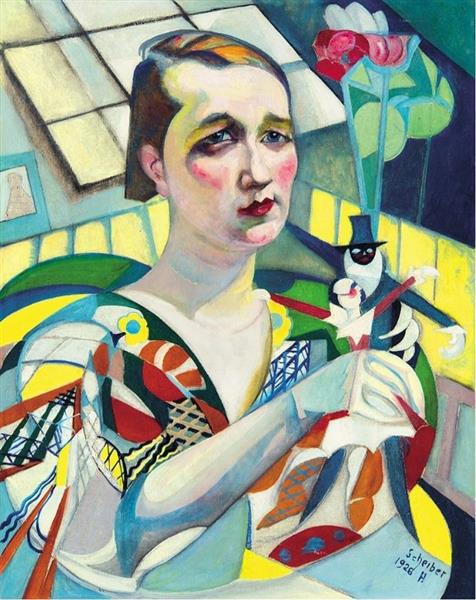Description
Alejandra's "portrait" (Portrait of Alexandra) by Hugó Scheiber is a work as enigmatic as captivating, which undoubtedly reflects the distinctive style and compositional mastery of the Hungarian artist. Scheiber, born in Budapest in 1873, is better known for his connections with futurism and expressionism, two movements that marked his style and artistic approach throughout his career.
When observing this painting, the first thing that stands out is the vibrant use of color. Scheiber uses a range of warm and cold tones that contrast and complement each other to give life to Alejandra's portrait. The bottom, full of variants of oranges, red and purple, creates an enveloping atmosphere that seems almost ethereal, directing attention directly to the central figure, but at the same time providing the work of exceptional depth and dynamism. The black and well -defined contours that frame their figure are characteristic of Scheiber's style and demonstrate their ability to capture the essence of their subjects with media economy and maximum expressiveness.
Alejandra, the portrayed woman, is represented with an expression that can be interpreted as introspective, insinuating an underlying melancholy or a deep contemplation. His gaze, not directed to the viewer but towards an indefinite point outside the canvas, suggests a personal and reserved narrative, inviting whoever observes to try to decipher it. Dressed in a clear blouse, its stylized figure is presented with a simple but eloquent elegance, embodying an idealization that is found in many of Scheiber's female portraits.
At the compositional level, the work shows a domain of balance and symmetry, where each line and each stroke seem to have been deliberately placed to guide the gaze of the observer from Alejandra's face to the most subtle details of the environment. The posture of the model and the soft modulation of the shadows add a touch dimension to the paint, almost as if the protagonist could be part of the physical space of the viewer.
Scheiber's technique, which fuses elements of futurism with a marked expressionist accent, is evident in "Alejandra's portrait." Futurists sought to capture the dynamism of the twentieth century, speed and continuous change, while expressionism focuses on the subjective representation of reality and transmitting emotions rather than realistic details. Scheiber achieves a synthesis of both: its use of bold colors and angular shapes provides vibrant energy and implicit movement, while the introspective nature of the subject resonates with the emotional depth of expressionism.
The lack of specific information about who Alejandra was and the precise context in which this work was carried out only to amplify its mystery and attractiveness. Like many great portraits, "Alejandra's portrait" does not offer us all the answers, but invites us to contemplate, question and imagine the stories not told behind that lost look and those enveloping colors.
Hugó Scheiber died in 1950, leaving a legacy that is still studied and celebrated in the history of modern art. "Alejandra's portrait" is one of those pieces that encapsulate the essence of his talent: a work that is not only seen, but feels deeply, talking directly to the emotions and imagination of the spectator.
KUADROS ©, a famous paint on your wall.
Hand-made oil painting reproductions, with the quality of professional artists and the distinctive seal of KUADROS ©.
Art reproduction service with satisfaction guarantee. If you are not completely satisfied with the replica of your painting, we refund your money 100%.

